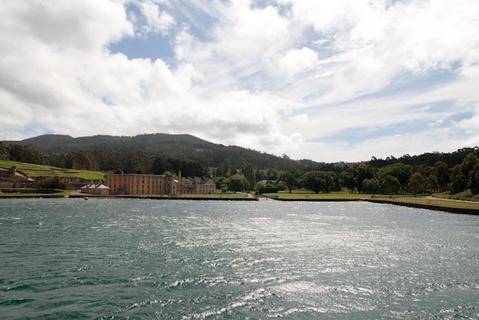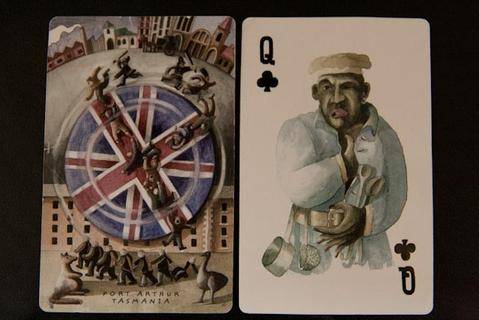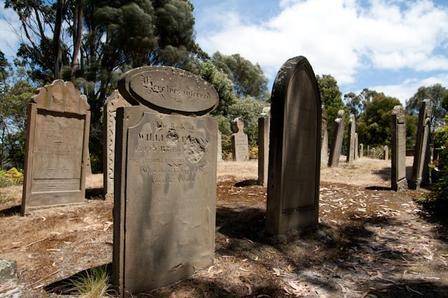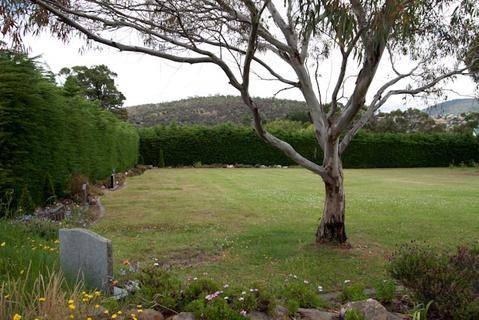A Black Presence in Van Diemen's Land
Caroline Bressey

Over 65 000 convicts transported to Australia were sent to Tasmania, over 4 in 10 of all those sent. Aboriginal communities have lived in Tasmania for at least 30 000 years, but within seventy-five years of the British military expedition arriving in 1804 the majority had been killed, murdered or ravaged by disease, or forcibly moved from their homelands and confined to reservations. The Aboriginal communities' numerous conflicts with the British, the convicts and their keepers was not only a conflict with whiteness. Black men and women came to Australia as colonial convicts and also as settlers. The origins of these early settlers include Africans from the Cape Colony, former slaves from the Caribbean and Black Britons such as the political prisoner William Cuffay.
Eleven properties from now form the Australian Convicts Sites added to the UNESCO list of World Heritage in 2010. Five of these are in Tasmania. Among the most extensive is Port Arthur, a site of more than 30 buildings, ruins, gardens and an island prison for boys. Established in 1830 to utilise convict labour in the production of timber for government projects, in 1833 Port Arthur became a secondary punishment station for repeat offenders from all of the Australian colonies.

On arrival at the Port Arthur Heritage Site visitors are given a playing card. You follow your character through the lottery of convict life displayed in the visitor centre. I was given the Nine of Diamonds, Ebenezer Brittlebank. A sixty-three year old man from Sheffield in England, Brittlebank was transported for stealing clothes and arrived in Van Diemen's Land in September 1825. Although I felt for the drunkard Brittlebank I traded him in for the Queen of Clubs, Thomas Day.
Born enslaved in Spanish Town, Jamaica, Thomas Day managed to get a passage to England where he worked as a cook and servant before being arrested and sentenced to seven years transportation at Maidstone Assizes in 1820. Day was transferred to Port Arthur when the notorious Macquarie Harbour penal station at Sarah Island on Tasmania's west coast was closed in 1833. During the introductory tour of the Port Arthur buildings another black convict is mentioned; the African inmate 'Samuel' given 75 lashes from stealing from the officers' allotment, now a soft carpet of lawn.

A short boat ride from the main site allows you to visit two islands off the main site. The Point Peur Boys prison where very little physical history remains, but our excellent guide Rob brought to life the difficulties and, albeit limited, opportunities the discarded youth of Britain encountered there. On the nearby Isle of the Dead the British class system remained engrained. Civil servants, regardless of their religious practice, and their wives and children were buried on the north side of the Isle of the Dead, their headstones placed upon higher ground. The convicts' graves lie unmarked on lower ground at the southern part of the island.
Returning to the main site from the Isle of the Dead visitors are able to take their own version of the iconic shot of the Penitentiary and its outlying buildings.
At this distance, for an imagination seeped in the historical imagination of television period dramas, as mine is, it is hard to see more than a country estate more pleasingly located than any English setting could provide. On a glorious sunny day it is harder still to conceive the historical and more recent horrors for which it has provided the scenery.
A museum housed in the prison's asylum, a tour of the separate isolation cells and a database search of the prisoners quickly reminds you of the grim life and injustice experienced by many of the prisoners. Punching 'Africa' into the database returned a few results including Samuel. The record shows Samuel (no other given names) was from the Cape of Good Hope, and was sentenced to life for theft. He arrived at Port Arthur on 1 November 1831. With him would have been 'Scipio Africanus' the name given to a man, also from the Cape of Good Hope, who was sentenced to seven years' transportation. He arrived on the Marion Watson on 30 October 1837. There is no detail on the database of what happened to either man before, during or after their confinement at Port Arthur.
At the site's gift shop the Pack of Thieves reveals the stories behind the men (they are all men) who inspired the images on the cards you are given on arrival. The pages on Thomas Day reveal that following the receipt of his third certificate of freedom he left Van Diemen's Land and sailed for South Australia, but in 1846 he was sentenced to another ten years' transportation for taking a pair of trousers from Zibulin Balt in Adelaide. He served his sentence at Port Arthur and left the penal colony once again. He appears to have died in the city of Launceston, in the north of Tasmania, in July 1860, alone and without family or close friends.
Three years after Thomas Day's final sentence was passed, William Cuffay arrived on the shores of Australia. The son of a formerly enslaved man from St Kitts, Cuffay is one of Britain's better-known Black Victorians. Brought up with his sister Juliana by their mother in Chatham, Kent, Cuffay trained as a tailor. In 1839 he joined the Chartist movement in support of the People's Charter, which demanded among other things, universal male suffrage and secret ballots. Although not the only Black man to be involved in the Chartist movement in London, Cuffay was to become one of the most prominent leaders in the city. Two leaders of a Chartist demonstration held in Camberwell in March 1848 were also 'men of colour' but Cuffay received the brunt of negative press and as a direct result his wife Mary Ann (who would later join him in Australia) was sacked from her job. Eventually Cuffay was expelled from Britain for his political activism with the movement but he did not allow his forced migration to break his commitment to the struggle of working people.
Cuffay's arrival in Van Diemen's Land in 1849 was reported in five Australian newspapers. Using nineteenth century Australian newspapers (now available freely online) Mark Gregory has established that just after a year in the colony Cuffay became involved in local workers' politics. In February 1851 he attended a meeting of the Free Trades Union called to discuss transportation and the use of convict labour for public projects. He later acted as an advisor on changes to the law in the colony's Masters and Servants' Act and organised a meeting in Hobart in 1857 to discuss newspaper reporting. Gregory has identified two of Cuffay's speeches which were published at some length in newspapers including one delivered at the Theatre Royal, Hobart in 1863 when Cuffay was in his mid-seventies.
Cuffay's wife Mary Ann died in 1869 in Hobart, and now poor and ill Cuffay passed the following year. The Tasmanian Mercury published an extensive obituary including the note that his remains had been interred in the Trinity burying-ground, and that by a special request his remains had been marked in case friendly sympathisers should later desire to erect a memorial stone. That graveyard no longer exists. In 1923 the bones were moved to a pauper's gravesite at Cornelian Bay Cemetery, Hobart, and as Gregory reflects there is now no memorial stone for Cuffay and probably no grave.

Fleshing out the stories of convicts from Van Diemen's Land beyond their entry lines in a register is difficult. A register of the first convict settlement on Maria Island contains at least one 'man of colour' known as James Dodds. A native of Dominica, Dodds worked as a servant before his trial and sentencing of seven years deportation in London in 1820. But what of his life before he left England and what happened to him after his discharge on 25 May 1826?
Thomas Day and William Cuffay are rare examples of transnational stories that can be made into biographies. What they both illustrate is the need for 'national histories' to expand their geographical imaginations and research programmes to include imperial connections and subjects recognising travel throughout the Empire, as free migrants, enslaved peoples or convicts forced to forge a life on the other side of the world from the places they had called home.
An extended version of this posting will be published as an essay in the BASA Newsletter 60/61 2012.
The original lithograph portrait of William Cuffay in Newgate prison drawn by his fellow Chartist and transportee Paul Dowling is on display as part of Victorian Connections at the National Portrait Gallery until 17 June 2012.
Between December 2011 and February 2012 Caroline Bressey will research the histories of the Black British presence in Australia as a Visiting Scholar at Monash University, Melbourne. As part of this trip she visited Tasmania in December 2011.
References
Beyond the Pale - world immigrants to Van Diemen's Land before 1900
Mark Gregory, William Cuffay in Tasmania, Tasmanian Historical Research Association, 58:1, April 2011, 61-77. For more on William Cuffay in Britain see Peter Fryer's Staying Power, Pluto Press, 1984.
Hamish Maxwell-Stewart & Susan Hood, Pack of Thieves? 52 Port Arthur Lives, Port Arthur Historic Site Authority, 2010.
Cassandra Pybus, Black Founders: the unknown story of Australia's first black settlers, University of New South Wales Press, Sydney, 2006.
_____________, A Touch of the Tar: African settlers in colonial Australia and the implications for issues of Aboriginality, London Papers in Australian Studies 3, Menzies Centre for Australian Studies, King's College London, 2001.
Brian Rieusset, Maria Island Convicts 1825-1832, Brian Rieusset, Tasmania, 2007.
 Close
Close


